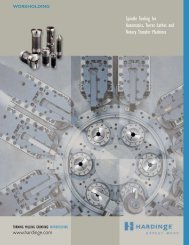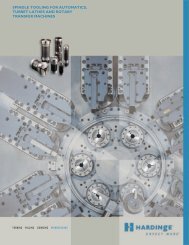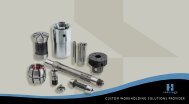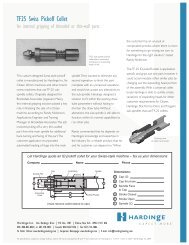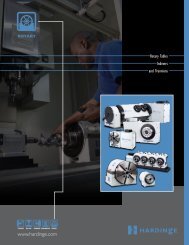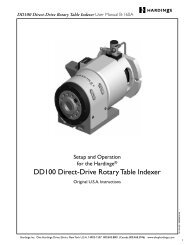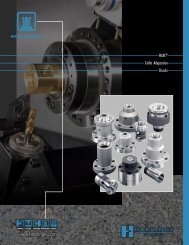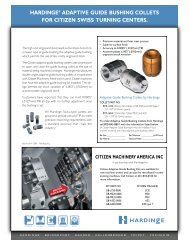You also want an ePaper? Increase the reach of your titles
YUMPU automatically turns print PDFs into web optimized ePapers that Google loves.
<strong>Sure</strong>-Grip ® <strong>Power</strong> <strong>Chuck</strong> Safety and Technical Manual B-87Z<br />
Determining the Length Factor<br />
The Length Factor relates to the ratio between the distance from where the cutting (turning) starts at the chucking end<br />
of the part, and the distance from the chucking end of the part to the top of the jaw. Other factors are also important in<br />
determining how well the part is gripped—they are: the cutting force determined by the feed rate and depth of cut, the<br />
specific cutting which relates to the material hardness and the feed rate and the chucking coefficient which relates to the<br />
chucking diameter and diameter being machined.<br />
Length Factor Sz (Approximate) – Table 5<br />
New <strong>Chuck</strong>s<br />
Older <strong>Chuck</strong>s<br />
Properly Serviced<br />
Ratio: <strong>Chuck</strong>ing length to distance between<br />
cutting and clamping points<br />
Lz: Distance between start of the cut<br />
and clamping point (bottom of step)<br />
Lsp: Length being chucked – from bottom of<br />
step or bottom of jaw to top of jaw.<br />
Lz ÷ Lsp is ≤ 3 ≥ 2.0 ≥ 2.4<br />
Lz ÷ Lsp is ≥ 3 and ≤ 6 ≥ 4.0 ≥ 4.8<br />
When to decrease the Length Factor:<br />
• Under normal unsupported turning conditions, the length factor should not be less than 2. When the workpiece<br />
length to diameter ratio (Lw ÷ D) is greater than 3, it is good machining practice to support the workpiece with<br />
a steady rest or tailstock. If a tailstock or steady rest is used, the length factor can be reduced to 1.<br />
• The length factor may be reduced by 30% when the workpiece is axially supported by a step in the jaws or a<br />
work-stop located against the face of the chuck. The operator must make certain that the workpiece is firmly<br />
seated against the stop when closing the chuck.<br />
When to increase the Length Factor:<br />
• Heavy facing cuts and heavy OD forming cuts may require the length factor to be increased by at least 50%<br />
or higher.<br />
Warning: Out-of-balance forces due to unbalanced workpieces and/or special shaped jaws are not taken into<br />
consideration in the above length factors. (Unbalanced conditions may cause the workpiece to come loose,<br />
resulting in damage to the machine and/or personal injury)<br />
Centrifugal Forces<br />
The gripping force of the rotating chuck is influenced by centrifugal forces. As the RPM of the spindle increases, the<br />
reaction of the chuck to centrifugal force also increases. At high spindle RPM, these forces can reduce the gripping force<br />
of the chuck substantially. Centrifugal forces must be taken into consideration when determining the initial gripping force<br />
of your chuck.<br />
Formula #3 Initial Gripping Force "Fsp Q" = Sz x (Fsp Z ± Fc)<br />
Sz = Length factor for the initial gripping force (see table above)<br />
Fc = Total centrifugal force of the chuck jaws (master jaws and standard blank pointed soft jaws)<br />
obtained from the "Centrifugal Force of Jaws corresponding to Angular Speed" graph on<br />
the following pages. (The + sign relates to external gripping, - sign to internal gripping)<br />
Fspz = Required total gripping force (without considering the effects of angular speed)<br />
NOTE: Separate centrifugal calculations must be made when special heavy top jaws are used.<br />
Hardinge Inc. One Hardinge Drive, Elmira, New York U.S.A. 14902-1507 800.843.8801 www.hardingetooling.com<br />
110



